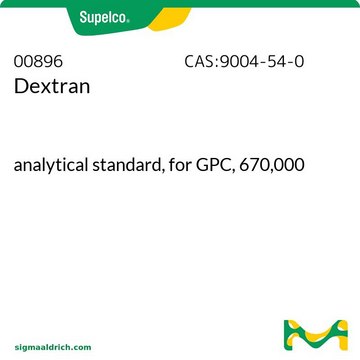8.18892
Poli(etilenglicole)
35000, (stabilised with 2-tert-butyl-4-methoxyphenol) for synthesis
Sinonimo/i:
PEG
About This Item
Tensione di vapore
<0.01 hPa ( 20 °C)
Livello qualitativo
Forma fisica
liquid
Temp. autoaccensione
>320 °C
Potenza
28000 mg/kg LD50, oral (Rat)
>20000 mg/kg LD50, skin (Rabbit)
pH
5-7 (20 °C, 100 g/L in H2O)
Punto di fusione
60-65 °C
Temp. transizione
flash point 260 °C
Solubilità
500 g/L
Densità
1.2 g/cm3 at 20 °C
Densità bulk
400‑500 kg/m3
Temperatura di conservazione
2-30°C
Stringa SMILE
C(CO)O
InChI
1S/C2H6O2/c3-1-2-4/h3-4H,1-2H2
LYCAIKOWRPUZTN-UHFFFAOYSA-N
Cerchi prodotti simili? Visita Guida al confronto tra prodotti
Applicazioni
- Hierarchically structured silica monoliths for the fabrication of micro-bioreactors.
- Micro-nanostructured PEG-DA (PEG-diacrylates) hydrogels for biomedical applications.
It can also be used as:
- A template to prepare micro/mesoporous structure of silica by sol-gel process.
- A stabilizing agent in the synthesis of metal nanoparticles.
Risultati analitici
Melting range (lower value): ≥ 62 °C
Melting range (upper value): ≤ 67 °C
Average molecular mass: 28000 - 38000
Identity (IR): passes test
Codice della classe di stoccaggio
10 - Combustible liquids
Classe di pericolosità dell'acqua (WGK)
WGK 1
Punto d’infiammabilità (°F)
281.5 °F - closed cup
Punto d’infiammabilità (°C)
138.6 °C - closed cup
Certificati d'analisi (COA)
Cerca il Certificati d'analisi (COA) digitando il numero di lotto/batch corrispondente. I numeri di lotto o di batch sono stampati sull'etichetta dei prodotti dopo la parola ‘Lotto’ o ‘Batch’.
Possiedi già questo prodotto?
I documenti relativi ai prodotti acquistati recentemente sono disponibili nell’Archivio dei documenti.
I clienti hanno visto anche
Il team dei nostri ricercatori vanta grande esperienza in tutte le aree della ricerca quali Life Science, scienza dei materiali, sintesi chimica, cromatografia, discipline analitiche, ecc..
Contatta l'Assistenza Tecnica.
